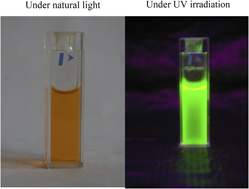Article contents
Highly fluorescent CdTe nanocrystals: Synthesis, characterization, property, mechanism, and application as a sensor for biomolecule analysis
Published online by Cambridge University Press: 04 March 2014
Abstract

Highly luminescent CdTe quantum dots (QDs) were prepared through a fast, facile, and straightforward method. The crystal structure, particle size, optical properties as well as molecular interactions between the CdTe QDs and their capping agents have been investigated by high resolution transmission electron microscopy, selected area electron diffraction, scanning transmission electron microscope–energy dispersive x-ray spectroscopy, UV-vis absorption, photoluminescence, and Fourier transform infrared, respectively. The results illustrate that the CdTe nanoparticles exhibit cubic structure and the average crystallite size is 2.3 nm. Meanwhile, fluorescence and UV-vis spectroscopic techniques were used to study the interaction between hemin and the well-defined CdTe QDs. In weak basic media, the fluorescence of CdTe QDs was quenched notably by hemin, and the quenching values were proportional to the concentration of the quencher in a certain range. The quenching mechanism was discussed to be a dynamic quenching procedure, collisional process, and hemin as a fluorescence quencher donated its electron to CdTe QDs to occupy the hole and accordingly disrupted the electron–hole recombination.
- Type
- Articles
- Information
- Copyright
- Copyright © Materials Research Society 2014
References
REFERENCES
- 11
- Cited by


